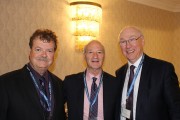Phil Kirby- Presentation Highlights
Most businesses we serve at HSS are entrepreneurial, all want to grow, and all have processes in their organization. However, you cannot grow and achieve vision by just looking at products and services- you need to consider process, too. But how do we go about this?
Customers want us to be fast, but they do not want to sacrifice cost and flexibility.
Think with a “process mind”. Visualize what your business is doing and get on the floor to see it. We process visual information 60,000 times faster than text.
- Wherever you have an exchange of information, you have a piece of process. But do not focus on these exchanges- processes for filling orders, transferring goods or getting paid- step back and look at the broad picture.
- Look at flow in value to get a win from activity. In any process, we are looking at a cash-to-cash cycle or a customer-to-customer cycle.
- Avoid fuzzy logic; don’t use technology that makes mistakes and causes headaches, regardless of what it may claim to do
- If you have chronic issues, institutionalize them into the process and find ways to solve.
Understand the purpose of the process. The raison-d’être for your business is to create value for the customer. We want to eliminate any step of the process that does not generate value, but many businesses are not aware of HOW they create value for the customer. Don’t classify processes by department or geography; sort them by time and sequence.
- What do you do when your customers want something different? Do you turn them away, invent and entirely new process to cater to them, or push a radically different product down the same process?
- 9/10 times, businesses will do the latter. If you’re going to offer something new, you need to think of a new way to do it.
- All processes can be categorized as follows. Which one does your organization follow? Does it follow more than one? Consider the following:
- Logistics- moving things from one place to another.
- Transactional- convert raw data into discernable information.
- Relationship- production and consumption are simultaneous, for example in a restaurant
- Knowledge- create and generate knowledge. Examples include architectural firms, engineering offices, accounting firms, or other professional services that create new answers for the client.
- Not all processes are alike- a logistics process may be machine-like, while a relationship process is a living, breathing thing that needs care. Regardless, all processes need standards to be measured against.
- If you do not have standards, you NEED to establish them- otherwise you can never improve!
- 80% of what you do in a business is reliable. It is routine and mechanical. If you do not have standards, you cannot detect variation and deviation from standards, and consequently you cannot establish what is normal and what is abnormal.
- Without standards, you can never tell if anything is wrong.
If you are able to take a step back and see the broad picture of your process, great- but you need to see it from the customers’ eyes. You need to experience your process, and consider it from the cusomter’s perspective- don’t try to optimize individual mechanical parts if it does nothing to improve overall experience. Build a problem-solving process. Don’t look at your organization structurally- look at it in terms of process.
Begin to think of your business as a system. A system is only concerned with what we do, and not what we spend. It is not concerned with financial structure. Your system is doing one thing- converting inputs from suppliers into outputs for customers in a competitive environment.
- Where is waste in a system? Waste manifests in several areas:
- Moving things around- always wasteful, does not add value.
- Waiting on things
- Overproduction- stems from thinking of what customers will order instead of responding to what they actually order
- Defects and extra-processing
- Inventory- think of this as time and opportunity cost.
- Waste can be a wonderful thing. It is a treasure. You need to expose the waste in your organization so you can understand what the waste is. You want people to bring forward problems so they can be solved, not hidden. When they come forward, be quiet and non-judgmental.
- Always assume that a problem is embedded in the process and not in the individual- a brilliant process managed by substandard people will always, always annihilate a substandard process managed by brilliant people.
So, what dimensions should be measured? There are two key ones to look at:
- Throughput. Don’t worry about utilization- you wouldn’t pay someone to drive your car around while you’re not using it all night, so why do the same with assets? You need to focus on measuring the flow of value to the customer.
- Time. Don’t spend a lot of money. Think about how to use what you have to speed up or reinvent the process.
And remember, don’t ever lose sight of customer value. Recall what happened with Toyota- the company went from trying to be the best car company in the world to being the largest. They lost sight of their original goals and grew faster than their infrastructure allowed- rather than taking a problem-solving approach, they rushed things, and as a result their image was severely tarnished. Toyota got back on track because they have the resources to do so- your business may not, so you can’t afford to make mistakes!






